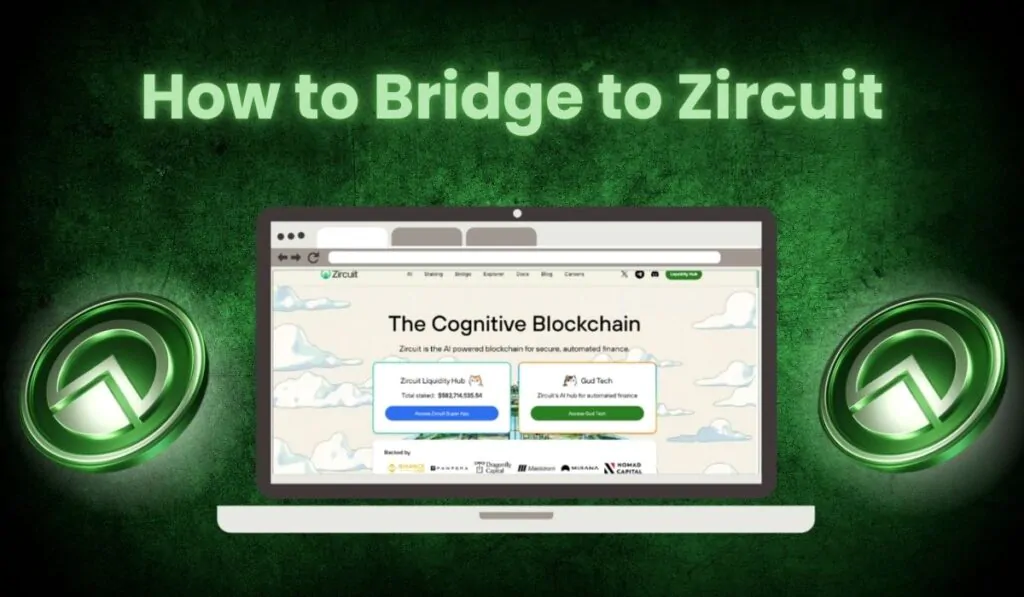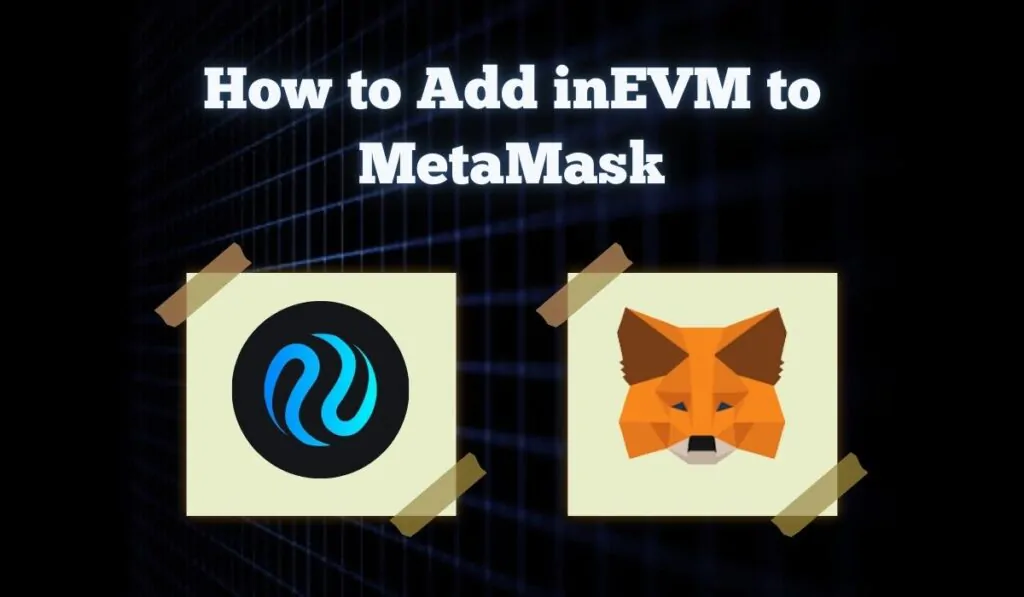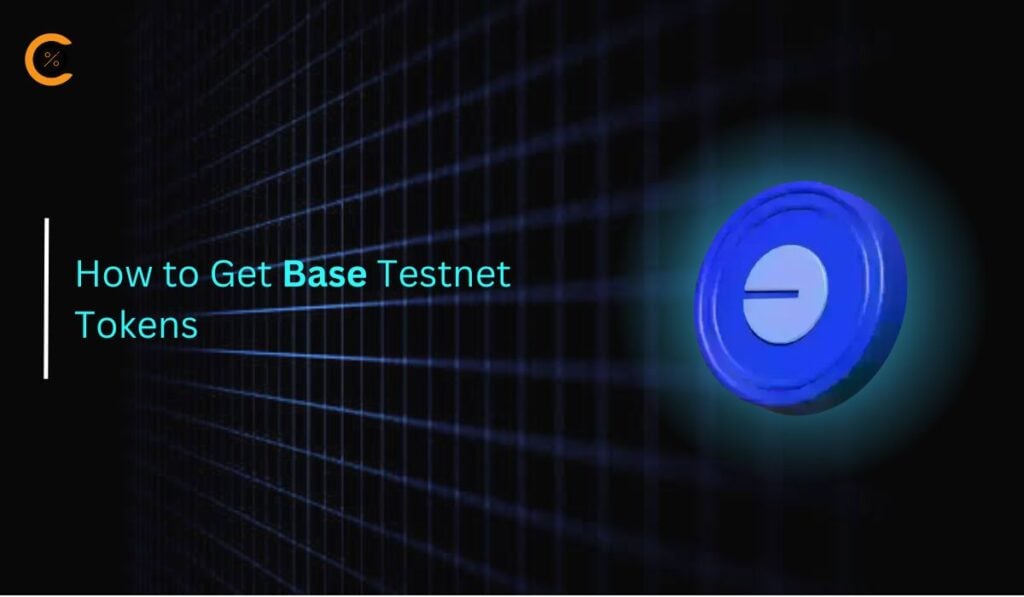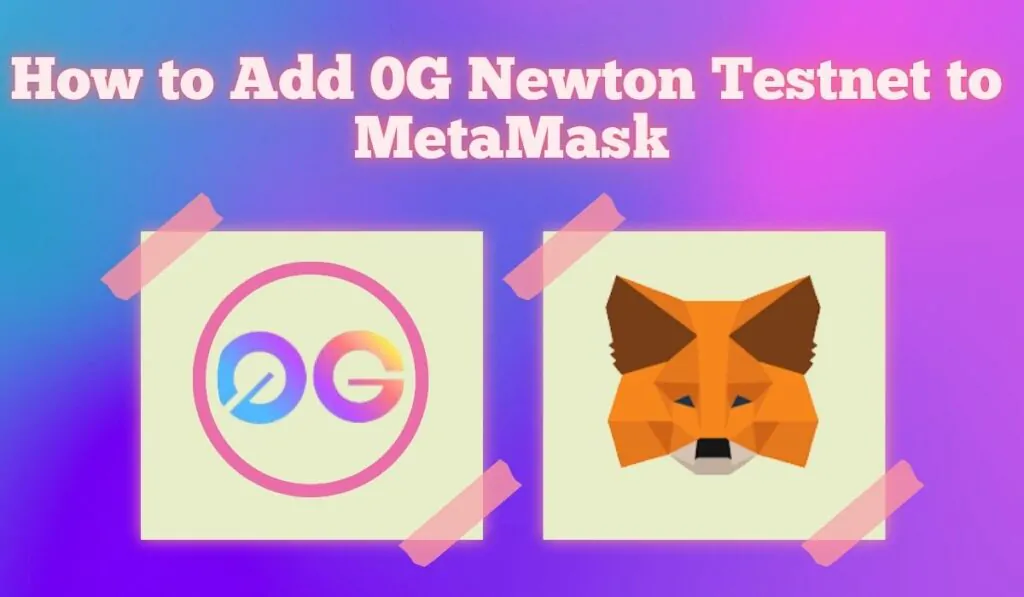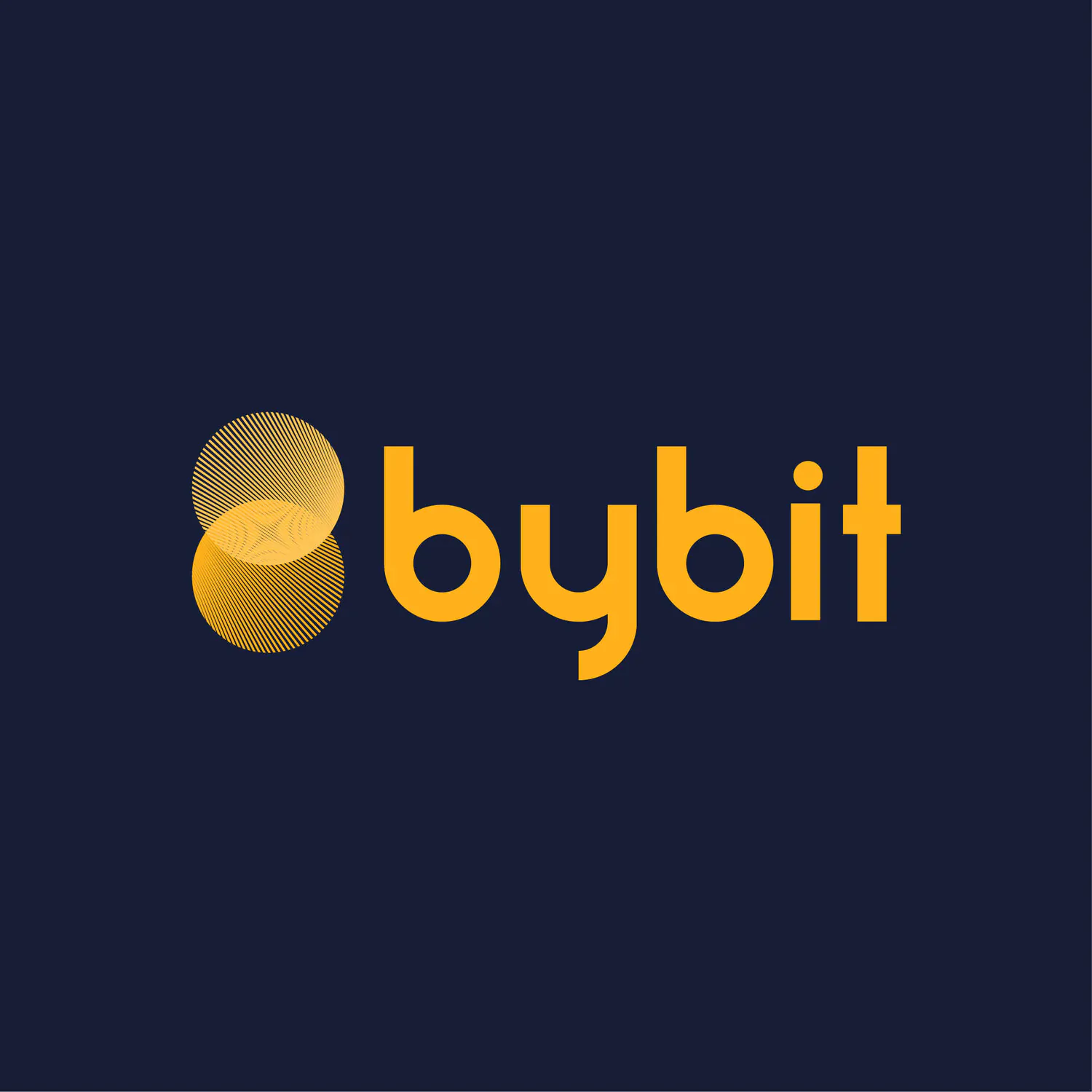Zircuit is a Layer 2 network built on Ethereum, featuring AI-powered security, full EVM compatibility, and reduced transaction fees. It uses zero-knowledge rollups alongside Ethereum’s infrastructure to deliver a scalable and dependable platform for decentralized applications, which often attracts users to explore the Zircuit’s ecosystem, including its dApps, staking protocols, and liquidity pools. If you’re looking to bridge to Zircuit from other networks, but aren’t sure where to start, this guide will walk you through the process step by step, so you can transfer your funds with clarity and confidence.
Can I Bridge to Zircuit?
Yes, you can bridge to Zircuit, but only if you’ve got the right tools. Dekho, bridging from one network to another in crypto is a technical process, and there’s no sugarcoating that. Sure, it feels similar to any other kind of transfer; whether traditional or digital, where you enter a recipient’s address and pay a fee. But in crypto, the tools are different, the steps are different, and the terminologies? Well, they take some getting used to.
Before we jump into the actual bridging process, let’s take a quick look at the prerequisites you’ll need to get started.
1. Gas Fees:
Just like any other transaction, crypto transfers also come with a fee—known as gas fees. On the Zircuit network, these fees are paid in $ZRC, the native token of the ecosystem. So, before you bridge any assets to Zircuit, make sure you have some $ZRC in your wallet. You can buy $ZRC tokens from popular exchanges like Bitget, which not only lists $ZRC but also supports the Zircuit network, making it easier to transfer and interact with the ecosystem right away.
Loading...
Rank #Token Symbol
-
All-Time High
-
Current Price
-
Market Cap
-
Total Supply
-
2. Wallet:
Once the gas fees are sorted, the next step is setting up a compatible Web3 wallet. Web3 wallets are essential for interacting with any decentralized app (dApp). If you want to use any part of the Zircuit ecosystem; be it staking, swapping, or using dApps, you’ll need a wallet that holds your $ZRC tokens.
Blockchain Wallet Finder
3. Add Support to Wallet:
By default, most wallets don’t support Zircuit right out of the box. You’ll need to manually configure it using the Zircuit RPC details, which are available on their official documentation. Make sure to add the Zircuit network to your wallet, as this step is necessary to see your $ZRC balance and interact with apps on the network.
How to Bridge to Zircuit?
With your wallet set up and funded with $ZRC tokens, your next move is to choose a bridge protocol. Now, there are a few solutions available; but which one you go with depends entirely on the network you’re bridging from or to Zircuit. Some bridges support specific chains, while others offer broader compatibility.
Using Zircuit Bridge
The first and most straightforward option is the official Zircuit Bridge. This bridge currently supports the transfer of $ETH tokens from the Ethereum network to Zircuit. While it might seem limited at first glance, it’s built and maintained by the Zircuit team itself, which means it’s highly secure, reliable, and tailored specifically for the network.
What sets the Zircuit Bridge apart is its user-friendly interface. Even if you’re not too technical, the bridge walks you through each step; from connecting your wallet to switching networks and initiating the transfer. It even offers built-in prompts to help you add Zircuit to your wallet if you haven’t done so already.
Step 1: Open your browser and head over to the Zircuit Bridge.
Step 2: Click on the “Connect Wallet” button to link your Web3 wallet (like MetaMask or Rabby) to the Zircuit Bridge.
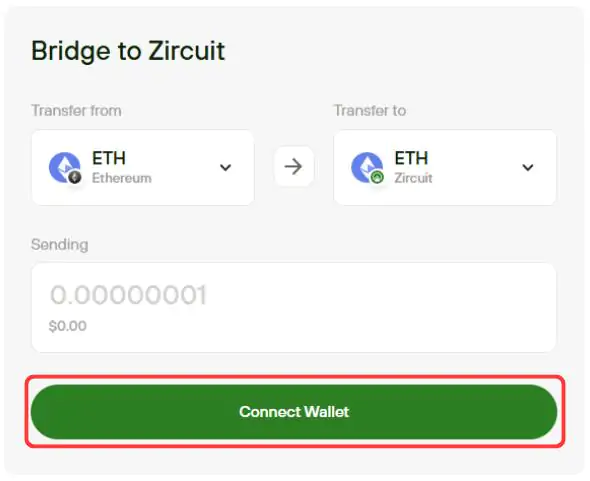
Step 3: There’s no need to manually select a network. The Zircuit Bridge only supports transfers between Ethereum and Zircuit, so the networks are automatically handled for you.
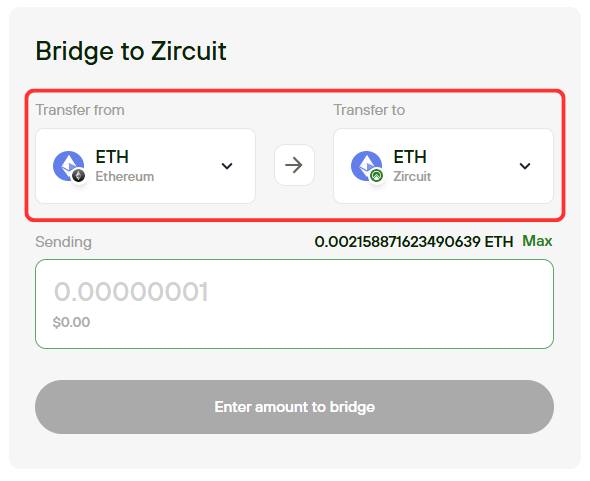
Step 4: In the “Sending” field, enter the amount of $ETH you want to transfer from Ethereum to Zircuit.
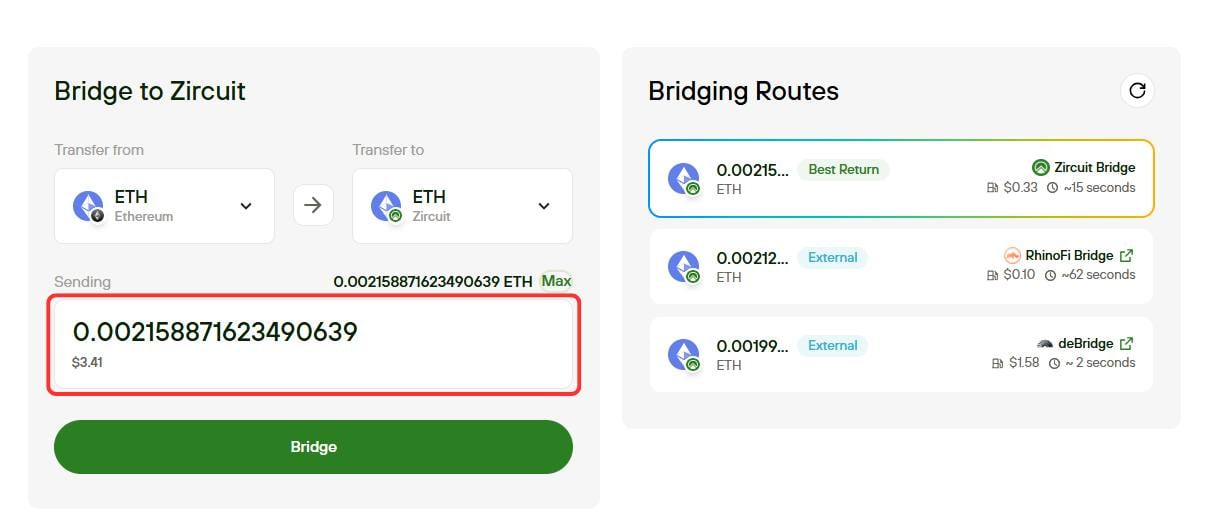
Step 5: The Zircuit Bridge also works as a bridge aggregator, meaning it shows you multiple route options for your transfer.

Step 6: Once you see the list, select a preferred route, then click “Bridge” to complete your transfer.
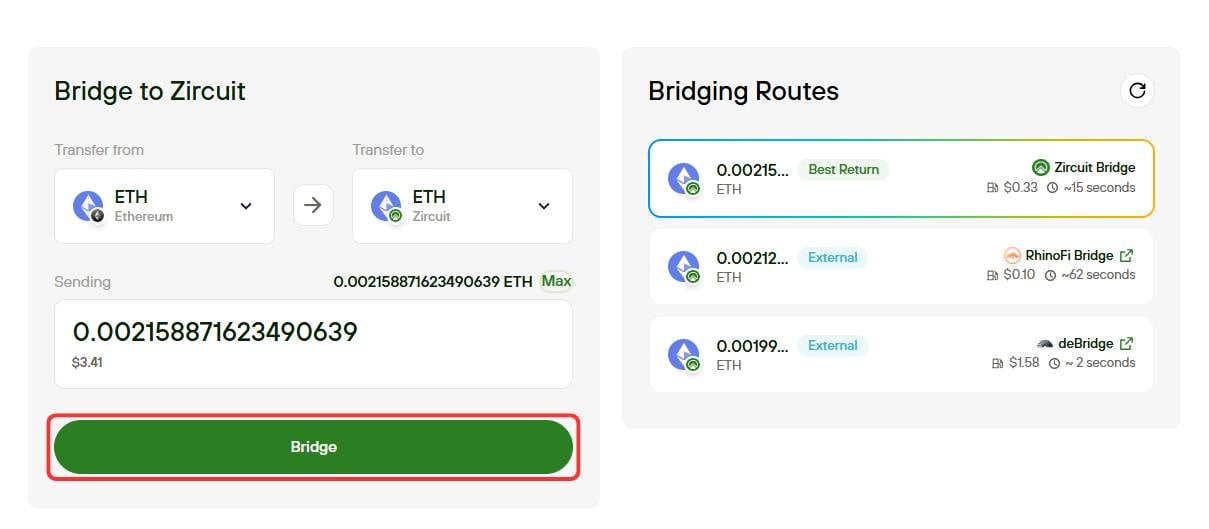
Using Orbiter Finance
The next option is Orbiter Finance, a bridge aggregator that supports over 70 networks, including Zircuit. It covers both EVM-compatible and non-EVM chains, making it a practical choice if you’re transferring assets from networks other than Ethereum.
Orbiter works as a cross-rollup bridge within the Ethereum ecosystem, offering a way to move assets between the Ethereum mainnet and various rollups, including Zircuit. Here’s how you can bridge to Zircuit using Orbiter Finance:
Step 1: Open your browser and go to the Orbiter Finance website.
Step 2: Click on “Connect Wallet” to link your Web3 wallet (such as MetaMask) to the platform.
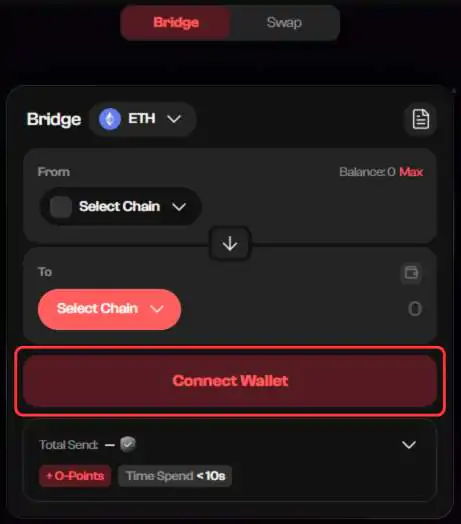
Step 3: In the “From” field, choose the network you want to bridge from. In the “To” field, select Zircuit as your destination network.
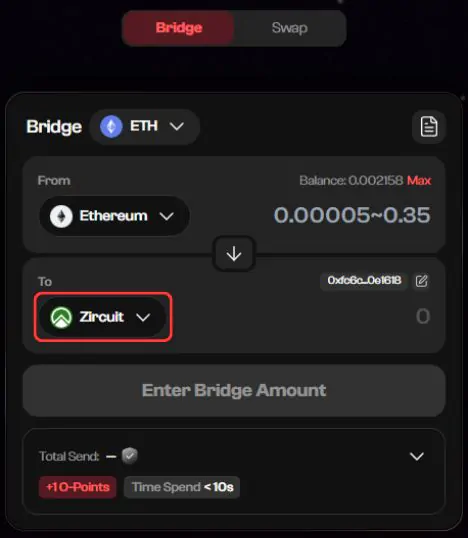
Step 4: Click the “Asset” dropdown menu and choose the token you’d like to transfer to Zircuit.
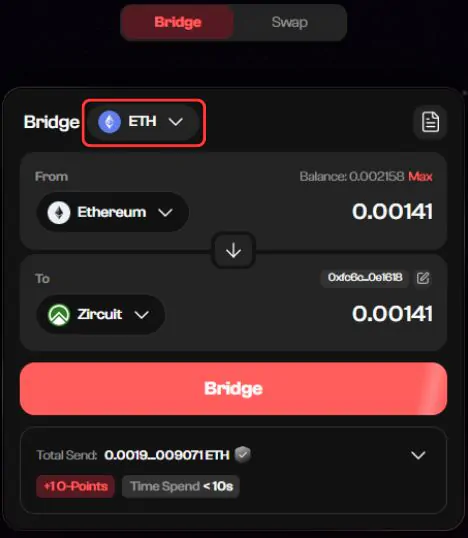
Step 5: Next, you will need to enter the amount you want to bridge to Zircuit in the input field.

Step 6: Review the transaction summary displayed below, then click “Bridge” to confirm and initiate the bridging process.
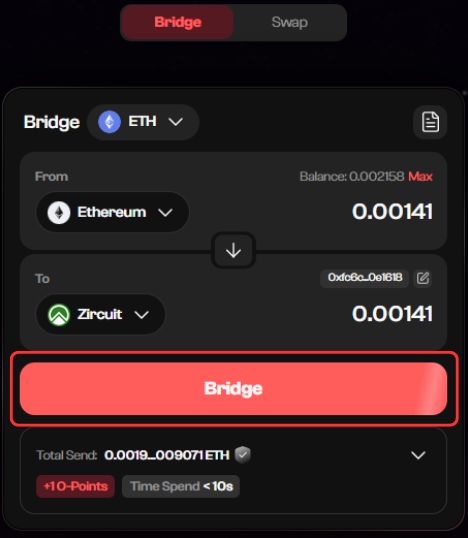
Zircuit Bridging Fees
While bridging to Zircuit, you’ll notice that the transaction fees are quite low. If you’re transferring from the Ethereum network to Zircuit using Orbiter Finance, the fee usually stays under $1. The same applies when using the official Zircuit Bridge.
However, if you’re transferring directly from exchanges like Bitget, the network fee is usually around 82 $ZRC tokens, which also translates to just a few cents, keeping your overall cost minimal either way.
Bottom Line
While Zircuit delivers a Layer 2 environment on Ethereum with AI‑powered security, full EVM compatibility, and lower gas costs, it rarely gets mentioned among the top layer‑2 solutions. Phir bhi, for users looking to bridge to Zircuit beyond Ethereum, bridge aggregators like Orbiter Finance provide access to a wide range of networks. The native Zircuit Bridge remains handy for straightforward ETH transfers with fees under $1. After bridging, you’re free to explore Zircuit’s dApps, staking protocols, and liquidity pools. From there, you can develop your own assessment of the network’s viability and growth potential.
FAQs
1. Is bridging to Zircuit reversible? Can I bridge my assets back to Ethereum?
Yes, bridging is typically a two-way process. If you’ve bridged assets to Zircuit and later want to move them back to Ethereum, you can use the same bridge (Zircuit Bridge or Orbiter Finance) in reverse. Just make sure the destination network is set to Ethereum, and you have enough ETH or ZRC to cover the return gas fee.
2. Can I bridge from non-EVM chains like Solana or Aptos to Zircuit?
Not directly (yet). Zircuit is an EVM-compatible network, so it works best with other EVM chains. However, if you’re bridging from a non-EVM chain like Solana, you’ll need to use a multi-hop bridge solution—first moving to Ethereum or a compatible chain, then to Zircuit. A bridge aggregator like Orbiter Finance is a solution that you’re looking for in such instances.
3. Does Zircuit have any incentive programs for bridgers or early adopters?
While not always guaranteed, many Layer 2 projects—Zircuit included—often roll out retroactive rewards or incentive programs for early users. If you’re bridging assets early and interacting with Zircuit-based dApps, you may qualify for a future airdrop or reward. Stay updated through Zircuit’s official Twitter and Discord.
4. What makes Zircuit’s AI-powered security different from other Layer 2s?
Unlike traditional Layer 2s that rely solely on protocol-level security, Zircuit enhances safety by integrating AI into its sequencer. This AI monitors for frontrunning, sandwich attacks, and suspicious patterns in real-time, reducing the chances of malicious exploits before they hit the chain.
5. Is zircuit EVM?
Yes, Zircuit is EVM-compatible, which means it supports Ethereum smart contracts, tools, and wallets without needing major changes. Developers can deploy their existing Ethereum-based dApps directly onto Zircuit, and users can interact with them using familiar wallets like MetaMask.

